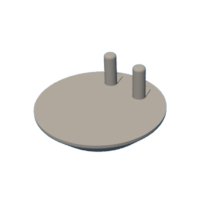Introduction: Transparent DML Speakers Made With Some Unconventional Materials!
Hello fellow makers,
As it's clear when looking at my Instructables page I love building weird speakers, one of my favourites to experiment with is the DML panels.
A while back I shared with you how to make your own small desktop panels using thin 3mm plywood and while they worked great my quest continued to find more panel materials ( yes as many YouTube videos will show high density extruded or expanded polystyrene do sound really good but can be quite the eyesore ).

Make your own Plywood DML Speakers
I recently saw a set of clear glass DML panels on the interwebs and I was hooked I knew it was something I have to try and make as none of us mere mortals had the kind of funds to buy said panels.
Trying to find the materials needed for this unconventional build seemed nearly impossible until a solution literally landed on my desk....
![]()
If you enjoy my Instructables and would like to support my future projects you can Buy Me A Coffee.
Step 1: What You Will Need:
To make your own glass speakers you will need the following:




- 2x 5-15W Sound Exciter
Amazon - Dayton Audio DAEX25CT-4
- 2x 10-12inch Tempered glass screen protectors
Amazon - 10.8 Inch Tablet Tempered Glass Screen Protector (these are the same ones I used)
- Access to a 3D printer or printing service
Amazon - Creality HALOT-ONE CL-60
- 4x 165mm 4mm diameter Brass rods
Amazon - 8 PCS 4mm/ 5/32 Inch Brass Rod
- B-6000 Adhesive
- 2 part CA glue kit
Amazon - MITREAPEL Ca Glue with Activator (2 x 1.7 oz - 2 x 6.7 fl oz)


*As an Amazon Associate I receive a small percentage from sales made through provided links at no cost to you, this helps fund future projects.
Step 2: What Is a DML Speaker:
Distributed Mode Loudspeaker (DML) is a flat panel loudspeaker technology, developed by NXT, in which sound is produced by inducing uniformly distributed vibration modes in the panel through a special electro-acoustic exciter. Distributed mode loudspeakers function differently from most others, which typically produce sound by inducing pistonic motion in the diaphragm.
Exciters for distributed mode loudspeakers include, but are not limited to, moving coil and piezoelectric devices, and are placed to correspond to the natural resonant model of the panel.
Advantages
Broad frequency range (100 – 18000 Hz for 0.6m2 panel).
The air radiation resistance is small and constant with frequency. This means that directivity is not affected by size of speaker.
Bipolar (radiates sound in 2 directions), but may be made forward directed.
Flat, don't require enclosing, may be produced in different shapes, may be decorated etc. Some DML units are designed to be plastered into walls and completely hidden.
Low cost of materials relative to traditional loudspeaker designs.
Disadvantages
Problems radiating low frequencies. Increase in size makes it possible to radiate sound with lower frequencies.
Low directivity and slow fading may lessen stereophonic sound impression. Still, listening from an off-center position gives some imaging of phantom sources as the other speaker can be heard with its full spectrum, but with extra delay due to the listeners local position.
Read more on Wikipedia
Step 3: The Sound Panel:
We start with the component that will be the determining factor on how your speaker will sound.
With this build I had my heart set on making a transparent set like I've seen on my Pinterest feed, now I had to figure out where I'm going to source the materials needed!
I knew from past experiments thin pieces of polycarbonate and acrylic sheets were too wobbly and thicker pieces had too much dampening and needed a lot of power and expensive exciters to drive them to reasonable volumes.
Now I'm sure there will be some exotic material out there that will also be worth testing and I'd like it if you guys can give some suggestions in the comments as I love experimenting with DML panels.
The solution hit me when my friend brought me his phone for a screen replacement, the replacement came with a free tempered glass screen protector, I got an idea...let's just test it out....
To my surprise even with my little 3W test rig exciter this piece of 6 inch glass sounded good and I mean really good!
I hopped onto the internet and found some discounted 10.8inch tablet tempered glass screen protector for only $2!
For my next iteration of the build I'd like to try and get some MacBook screen protectors to try ~14inch size panels.
First thing I needed to do was to get rid of the silicon adhesive on the protectors, I when through my chemicals and nothing dissolved the adhesive!... frustrated I started scraping at it that's when I realized the adhesive layer is a sticker. 🤦♂️

By using a heat gun I heated the glass protector and started tearing off the film in sections to avoid putting too much force on it and risk breaking it, remember this glass is THIN.
Step 4: Design and Printing the Speaker Components:
Using my go to design software Fusion 360 I designed a minimalist stand for the glass panel that will compliment the glass.
The design was lead by the need to cover up any notches that was in the screen protector originally intended for the cameras and earpieces of the device.
The final design should work for most designs of screen protectors.

I will include all original design files if you want to make any changes.
The exciter enclosure is designed around a 44mm 15W Chinese sourced driver but has no direct effect of the DML panels and can be made according to your exciter.
All parts in my build was printed in regular Creality rigid resin.

After printing I sprayed all of the parts in a vintage looking metallic forest green to compliment the brass rods I will use as supports for the glass panel.

Glass DML
Step 5: Assembling the Printed Components:
With the needed parts printed and painted we can start assembling the parts.
Starting with the stand I cut four 4mm brass rods to 163mm length filed away any burrs and polished them to a shine with some metal polish.

Next using B-6000 glue for its vibration dampening quality and strong hold I added a drop into each of the 4mm holes in the "Glass Back Support" spheres, next I pushed in a brass rod into each sphere.

Now we will press two of the assembled brass rods into each of the bases making sure the two small dots on the back support spheres point outwards.
You can slot in one of the glass screen protectors just to align the rods and make sure the glass lays flat against the supports.

With the bases assembled we can move on to the exciter assembly.
When I originally received the exciters they had a metal plate over the voice coil that you can attach them by, but as I discovered in my previous DML Instructable this metal plate greatly degraded the sound and I stripped them from the voice coil.
To replace these metal plates I printed some new plates that fit inside the voice coils using a small bead of 2 part CA glue around the edge of the voice coil.
From my original Instructable - Plywood DML Speakers

When I received my newest batch of exciters they had a round steel plate on the front of the voice coil for mounting. I thought this was quite neat as it made mounting a lot easier but after mounting them to a test panel I was very disappointed, the sound was muddy and had no output above 500Hz.
At first I thought it might be the panel material so I tried a few different panels, same result every time.
So it was time for a lil dissection...
Removing the plates turned out to be a lot more difficult than I anticipated, I started with a very thin blade and pried between the plate and the voice coil... be very careful!
When I had a small gap I dripped some isp alcohol on the joint to loosen the glue a bit, I was careful not to get alcohol on the rest of the exciter as I didn't want to risk dissolving any other glues.
Unfortunately on both of my exciters the plastic supporting ring below the plate also broke when I removed it so I decided to print a new ring that would then also be used to mount the exciter.
I used the same 2 part CA glue to stick the new ring onto the voice coil.
Placing the exciter with the new mounting ring onto the panel I was relieved that the sound I knew and loved was back.
Lesson learned metal mounting plates degrade the sound horribly.

Solder on two wires onto the terminals of the exciter before glueing them into their enclosure by using the same 2 part CA glue. The final part is the small terminal cover that just hides the unsightly terminal connection we can see from the front due to the transparent panel.

Step 6: Assembling the Glass Panel:
Now onto the delicate process of assembling the glass panel.
Usually when it comes to DML panels we mount the exciter in a 2/5 3/5 position but in my experience with tiny panels like these I like the reproduction better when the exciter in a central position.
To prevent any damage to the glass screen protector I place it onto the soft foam cover it originally shipped it as it might crack if there is dirt under it when applying pressure in the next step.
To adhere the exciter to the glass panel I started marking out the centre of the glass with a white board, I then marked out a circle slightly bigger than exciter that way we can easily position the exciter inside the circle as you only have about 3 seconds to position it before the glue hardens.
I spray a light most of the 2 part CA glue activator onto the glass then put a pea sized drop of CA glue onto the centre of the exciter mounting plate, position over the circle and stick it down lightly hold it down in place for about 5 seconds.
Next we need to attach the assembled glass panels to the bases.

We will be using B-6000 glue to aid in vibration dampening, I started by masking off the base on opposite sides of the glass panels slot to prevent excess glue from damaging the paint.
Add a bead of B-6000 inside of the slit and on the face of the support spheres then slide the glass panel into the slit and press onto the glue on the supports making sure your panels are centered.

You can then place some glue on the front glass support covers and press them into place.
Step 7: Finishing Off the Build:
As this pair is simply a prototype to test out the viability of the glass panels I will for now only cover the front where we stuck the exciter assembly to the glass with a matt black sticker to hide the glue, I want this to be removable as I want to test out some whizzer cones in the future to see if it makes any difference.
Otherwise I will just design an emblem that will go on instead of the sticker to make it neater.
The last step before we get to test out our speakers is to solder on some wires.

Whilst designing the base I completely forgot to add some passages for the wires to run through out the back so I had to use a carving bit in my Dremel to make some slots for the wires but I have fixed the design so you should be ok! 😂
I simply soldered the coiled decorative wire from the exciter assembly onto some regular speaker wire and covered the connections with heat shrink tubing.
I know a lot of people would prefer a connector instead of the wires but it was difficult to find a commonly available connector that will fit the low profile at the back.

Step 8: Updates:
Step 9: Test Them Out!
The time has come to hook up your new creations and test them out!
I find it best to use any DML panels crossed over with a subwoofer to truly bring them to life.
I hope you guys find this Instructable useful and if you have any questions please feel free to leave me a message or comment bellow.
Thank you for taking the time to read through my project and as always..
Happy making!
---

Grand Prize in the
Unusual Uses Contest




















